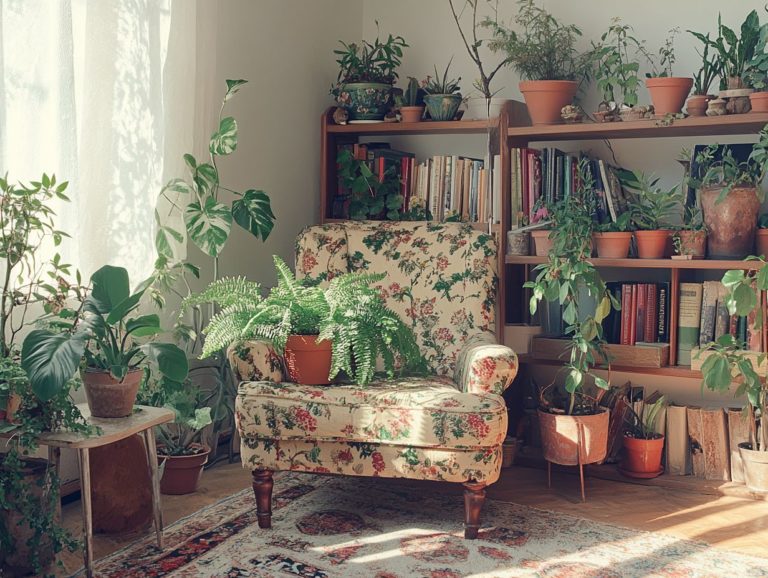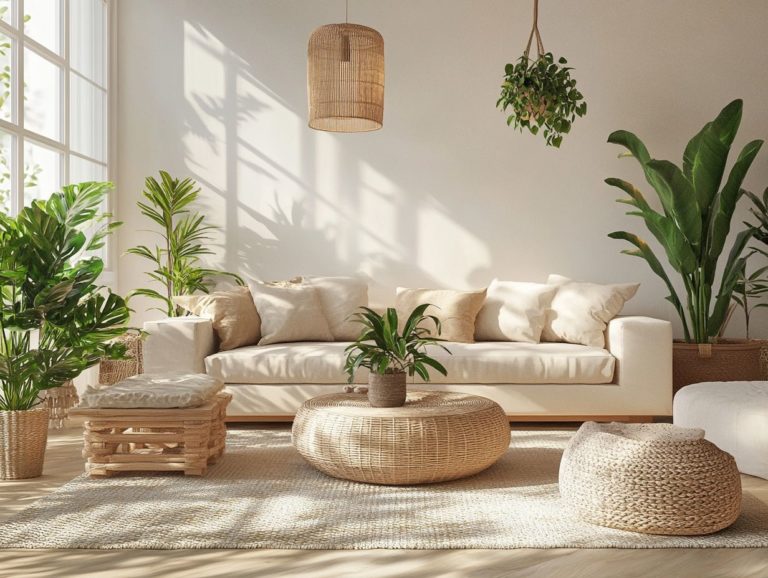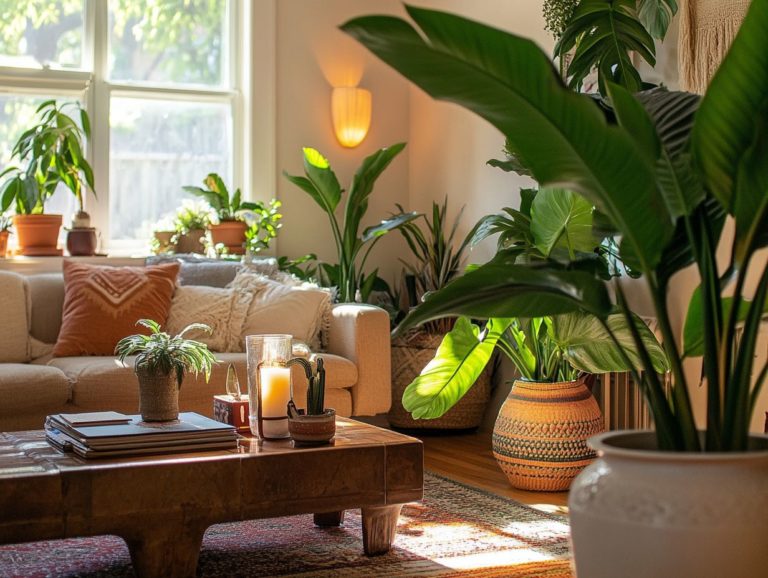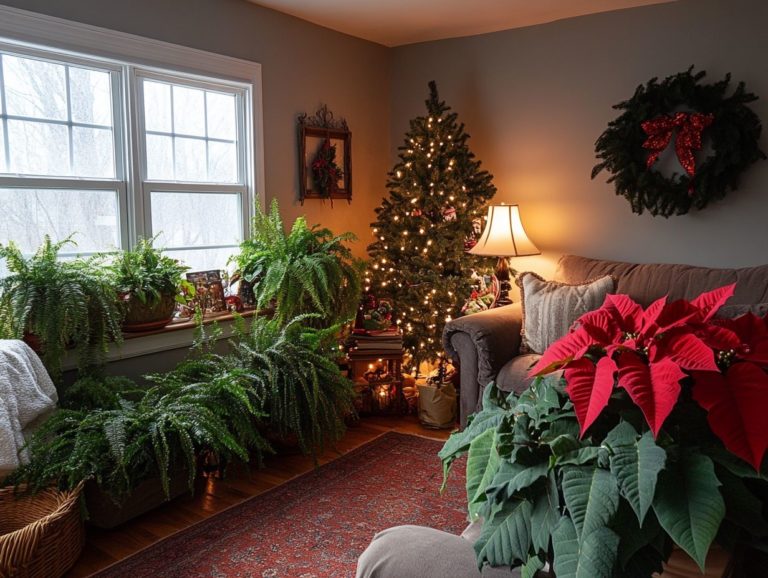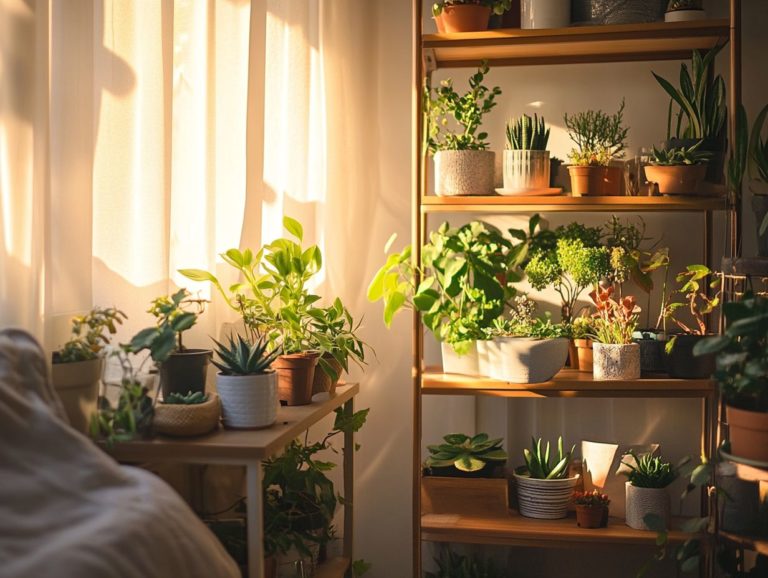Creating a Green Wall: A Beginner’s Guide
Imagine the transformation of a mundane wall into a lush oasis of greenery. Green walls, often referred to as vertical gardens, elevate the aesthetic appeal of any space and contribute to environmental benefits such as enhanced air quality and increased biodiversity.
This guide will lead you through the different types of green walls. It will assist you in selecting the perfect plants and offer a comprehensive, step-by-step approach to building your own.
Uncover essential gardening tips and innovative design ideas to ensure your green wall thrives. Don t miss out on the chance to bring nature right into your home!
Contents
Key Takeaways:
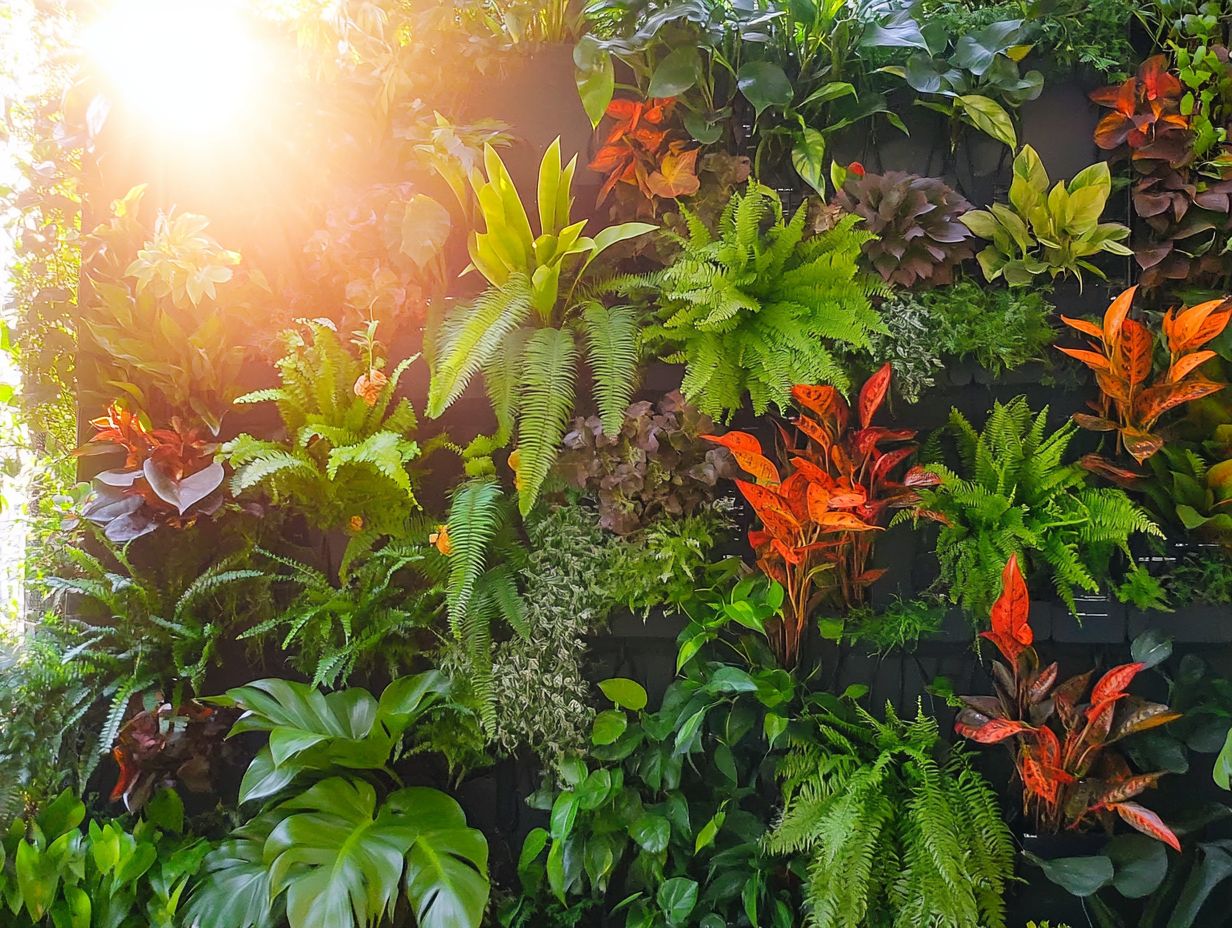
- Green walls provide both environmental and aesthetic benefits, making them a great addition to any space.
- When choosing plants for your green wall, consider factors such as lighting, irrigation, and maintenance requirements.
- Building a green wall is a step-by-step process that requires careful planning, proper materials, and regular maintenance to keep it healthy and thriving.
What is a Green Wall?
A green wall, often referred to as a living wall or vertical garden, is an innovative horticultural design that integrates various plant species into a wall structure. This design enhances aesthetic appeal and promotes environmental sustainability.
You can use these installations both indoors and outdoors. They create a thriving habitat for biodiversity while significantly improving air quality in urban settings. Crafted with cutting-edge irrigation systems and growing mediums, green walls showcase the beauty of nature in a vertical format.
Typically, a green wall features a delightful mix of wall shrubs, climbing plants, and even moss walls. All these elements contribute to a lush, vibrant appearance. By opting for peat-free compost, these installations minimize their environmental impact, ensuring sustainable plant growth without harmful materials.
The use of screws that secure themselves during installation enhances the wall’s structural integrity while simplifying the assembly process. Ultimately, green walls embody a harmonious relationship between urban architecture and the natural world, allowing you to reconnect with nature and elevate your surroundings.
Benefits of Green Walls
Green walls present a wealth of advantages that go far beyond mere aesthetics. They play a crucial role in environmental sustainability and bolster biodiversity.
These vertical gardens not only catch your eye, but they also contribute to energy efficiency by offering natural shading during warmer months. This lessens the need for artificial cooling systems.
They also inspire community planting initiatives that promote eco-friendly designs. This creates a harmonious blend of beauty and purpose.
Environmental and Aesthetic Benefits
The environmental and aesthetic benefits of green walls are remarkable. They significantly enhance air quality, boost biodiversity, and contribute to energy efficiency in urban settings.
These living installations act as natural air filters, effectively absorbing volatile organic compounds that can affect air quality while providing habitats for native plants and wildlife. Plus, they deliver an eye-catching aesthetic that can transform any indoor or outdoor space.
Take Waddesdon Manor, for example. The integration of a green wall there has achieved a 30% reduction in air pollutants, encouraging a thriving ecosystem of various bird and insect species.
Similarly, Le Manoir aux Quat Saisons features a stunning vertical garden that elevates the property s beauty while decreasing heating and cooling costs by offering essential insulation.
Research shows that these installations can lower urban temperatures by as much as 5 degrees Celsius. This promotes a more sustainable urban habitat that appeals to both residents and visitors alike, enhancing the overall living landscape.
Types of Green Walls
Green walls can be divided into two main categories: vertical gardens and horizontal green walls. Each has unique characteristics and benefits based on the type of wall you choose.
Vertical gardens feature climbing plants and wall shrubs. They maximize space efficiently, making them ideal for urban environments where every square foot counts.
In contrast, horizontal green walls provide a larger planting surface. This allows for a wide variety of plant species to thrive, including summer interest plants that enhance seasonal appeal.
Vertical vs. Horizontal Green Walls
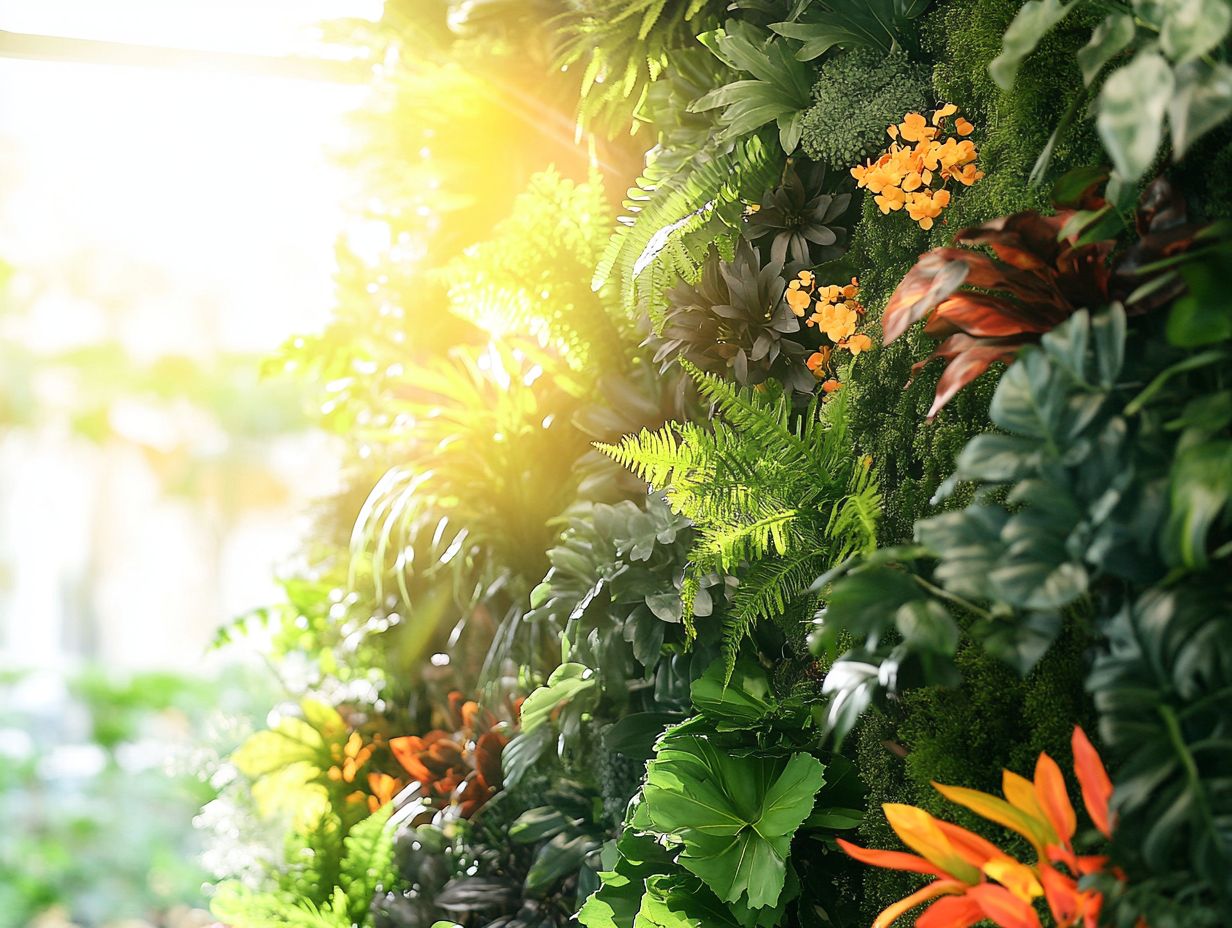
The main difference between vertical and horizontal green walls is their orientation and functionality. Vertical gardens thrive in compact spaces and use innovative watering methods and structures to support climbing plants.
On the other hand, horizontal green walls can host a broader variety of plants, enhancing their visual and ecological impact.
Each type of green wall has its advantages and disadvantages, particularly in terms of maintenance and aesthetic appeal. Vertical gardens require more frequent watering and specialized care, but they create stunning displays that can transform any urban area.
Horizontal green walls can support various plants, like succulents and vibrant annuals, which need less upkeep and add lively colors. Popular species such as ferns and ivy excel in vertical designs, while grasses and flowering plants thrive in horizontal installations, enriching the ecosystem.
Choosing the Right Plants
Choosing the right plants for your green wall is essential for its health, aesthetic charm, and environmental benefits. Focus on native plants and climbing varieties.
Select suitable species like summer interest plants that thrive during specific seasons. Create your stunning green wall and support local biodiversity!
Factors to Consider
When selecting plants for your green wall, consider factors like climate, soil type, and maintenance needs. Understanding different watering methods and plant requirements is crucial for successful growth.
One key factor is sunlight exposure. Various plants thrive in different light conditions, which affects their growth and health.
Consistent watering is vital. The amount and frequency depend on the plant species and environmental conditions, including temperature and humidity.
Seasonal changes are important, too. Some plants perform best at certain times of the year, enhancing the beauty of your outdoor green space.
Choosing the right soil blend, like peat-free compost, boosts nutrient availability and moisture retention. This thoughtful approach helps ensure your green wall is vibrant and thriving.
Building a Green Wall
Creating a green wall requires a good understanding of the installation process. Start by selecting the right watering method and structure. Use materials like self-tapping screws and cable ties for strong support.
This DIY project can transform any outdoor or indoor space into a vibrant ecosystem. Elevate both its aesthetic appeal and environmental benefits through careful plant selection!
Step-by-Step Guide
A step-by-step guide to building your own green wall involves several essential tasks, including preparing the installation, selecting the right irrigation system, and choosing the plants that will thrive in your environment. Each phase is crucial for establishing a sustainable and visually striking vertical garden.
To kick off your project, first assess the wall s condition. Ensure it can support the weight of the greenery. This preparation is vital; a sturdy foundation will significantly influence the longevity of your green wall.
Next, assemble the framework carefully. Ensure it’s securely mounted and ready for planting. Choose an efficient irrigation system tailored to your selected plants to guarantee they receive the right amount of water and nutrients.
During the planting phase, consider the sun exposure and growth habits of each plant. This will help you cultivate a balanced and thriving ecosystem. Regular maintenance such as pruning, watering, and fertilization is essential to keep your wall vibrant and healthy throughout the seasons.
Maintenance and Care
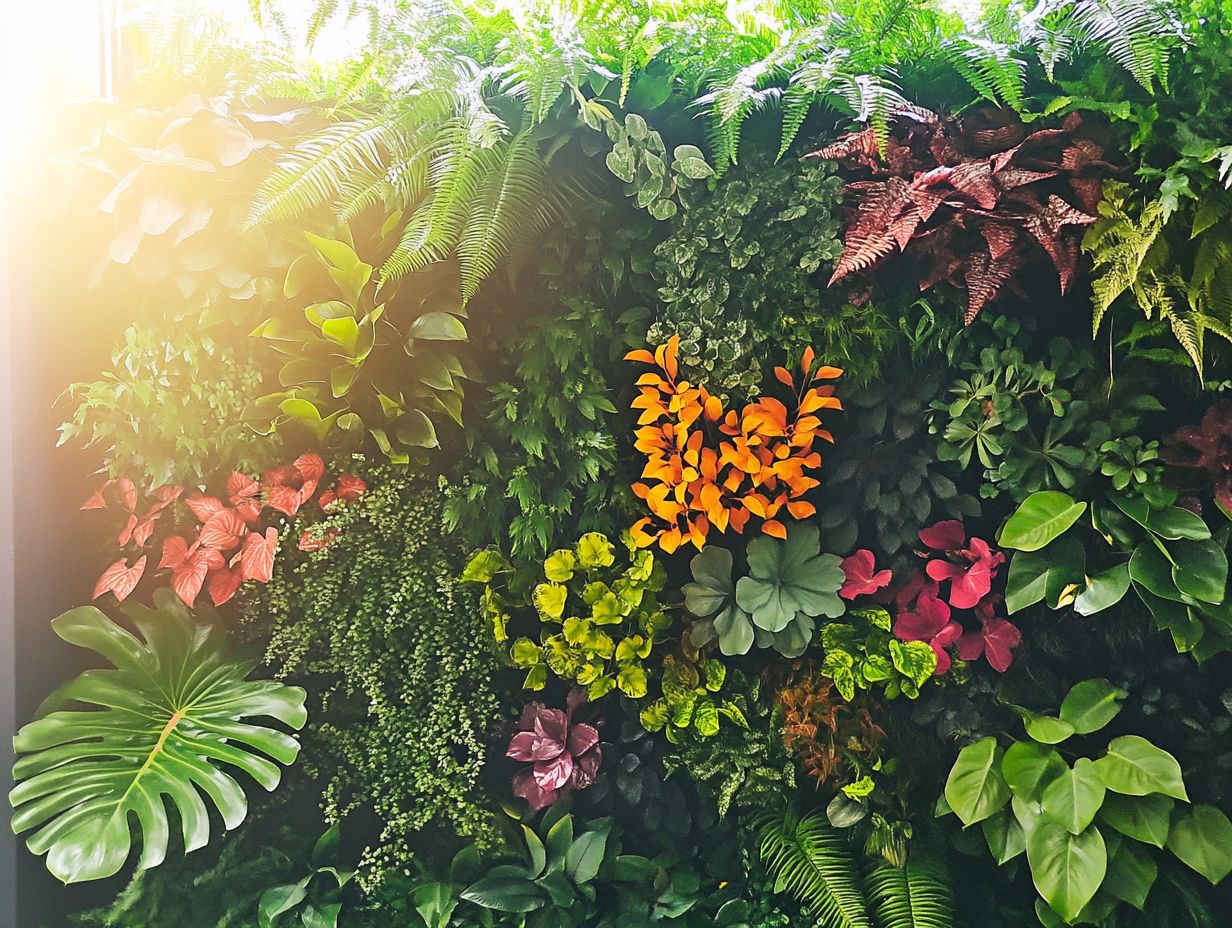
Regular maintenance of a green wall is crucial for promoting healthy plant growth and preserving its visual appeal. This entails routine tasks such as:
- Monitoring irrigation systems
- Using a watering can for manual watering when needed
- Applying gardening strategies tailored to the types of plants in your wall
By committing to these practices, you ensure your green wall remains vibrant and thriving.
Tips for Keeping Your Green Wall Healthy
To maintain the health of your green wall, focus on regular watering, nutrient supply, and effective pest control methods. Provide your plants with sufficient light and moisture, while keeping an eye out for signs of distress. This will promote vigorous growth and vitality.
As cooler seasons approach, scale back on watering to prevent root rot. Adjust your care routines according to the changing seasons; during warmer months, increase your watering routine and use organic fertilizers to meet growth demands.
Pest infestations are another challenge you might face. Employ simple pest control methods, like introducing beneficial insects or using organic repellents, to address these concerns. Regularly inspect the foliage for signs of disease or pests to ensure your green wall flourishes year-round.
Creative Ideas for Green Walls
In terms of green walls, you can explore a world of creative ideas that blend innovative designs with unique applications, enhancing both functionality and aesthetic appeal in your spaces.
By incorporating a diverse array of plant types and crafting artistic patterns, these living landscapes showcase the boundless possibilities that green design offers. Don’t wait too long to start planning your green wall!
Innovative Designs and Uses
Innovative designs and uses of green walls can transform urban landscapes. They foster biodiversity and urban agriculture, all while elevating aesthetic appeal.
These installations do many things. They purify the air and produce fresh food in community gardens, bringing nature into our lives.
Take, for instance, the vertical farm in Singapore. It exemplifies how green walls can maximize limited space while supplying local markets with fresh herbs and vegetables. Such designs support urban agriculture and attract a variety of pollinators, enriching the urban ecosystem.
Community projects in New York City use green walls to transform rooftops and neglected structures into vibrant spaces for food cultivation. These exciting initiatives highlight just how vital sustainability is in our cities!
These innovative solutions showcase the versatility of green walls, making them essential elements in the quest to green urban areas.
Frequently Asked Questions
What is a green wall?

A green wall, also known as a living wall or vertical garden, is a wall covered in vegetation. It can be either a self-sustaining system or require manual maintenance.
Why should I create a green wall?
Green walls boost air quality, cut noise, and beautify spaces inside and out!
Do I need any special skills to create a green wall?
No, creating a green wall is a beginner-friendly project that only requires basic gardening knowledge and some DIY skills.
What materials do I need to create a green wall?
The materials needed will depend on the type of green wall you choose to create. Common materials include a frame or structure, plants, soil, and an irrigation system.
Can I create a green wall in any space?
Yes, you can create a green wall in almost any space as long as it receives adequate sunlight and has proper ventilation. You can even create a small green wall indoors using a vertical planter or hanging pots.
How do I maintain a green wall?
The maintenance required for a green wall depends on its specific design and the plants used. Regular watering, pruning, and fertilizing are typically necessary to keep the wall healthy and thriving.
Ready to bring some greenery into your life? Start your own green wall project today, and transform your space into a vibrant, sustainable oasis!

